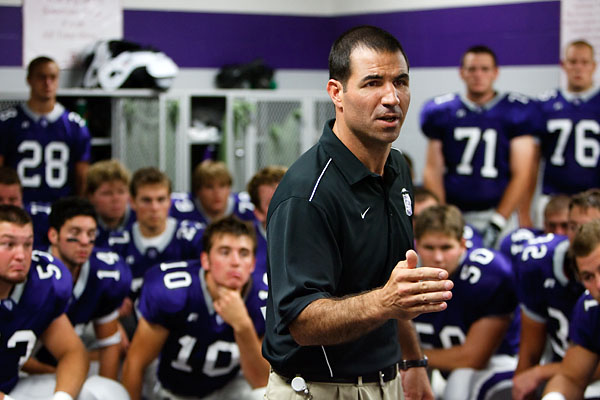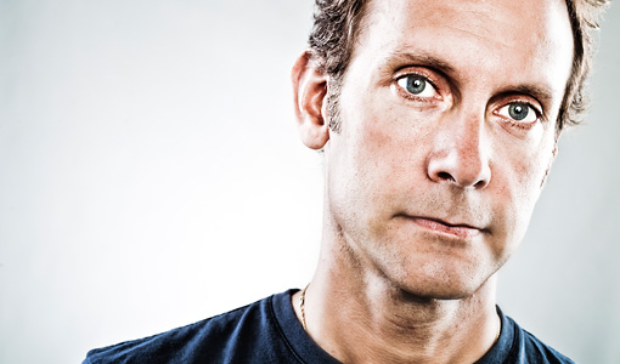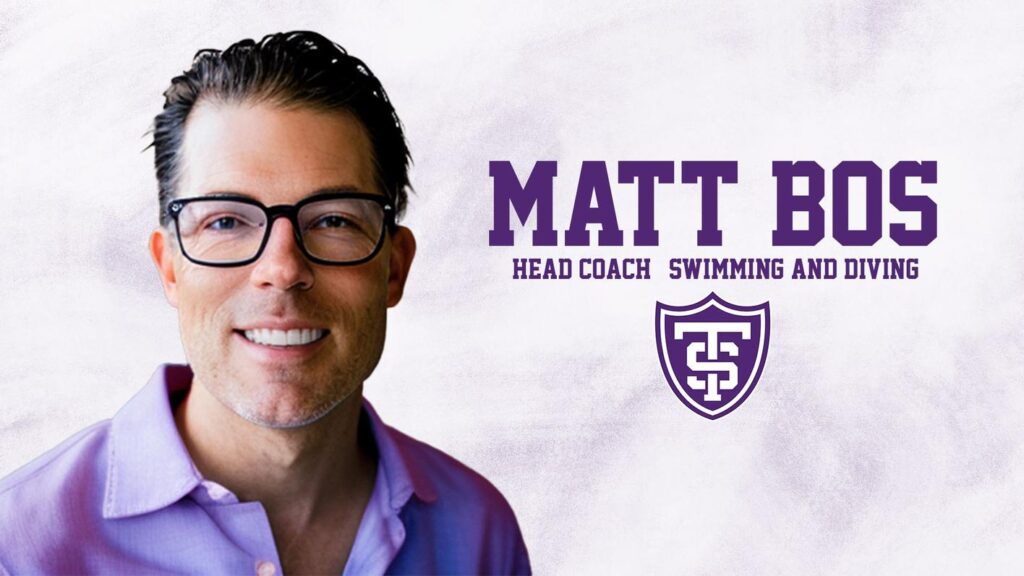I never played football, never attended a game while I was a student at St. Thomas, and never understood the sport. And so, curiously, as a follow-up to my first feature film, “Sweet Land,” I chose Division III football as a subject.
While “Sweet Land” was playing in theaters, I received several books and ideas from people suggesting a second film, but only one caught my attention. It was a manuscript for a book written by Ed Flaherty, a successful businessman and investor from Eden Prairie, who had grown up in Montana playing football.
Ed’s high school had closed down not long after he graduated and events like reunions and capital campaigns were nonexistent. His high school football team, the Mustangs, was an undistinguished group of young men guided to the 1962 state championship by two extraordinary coaches who instilled not only football fundamentals, but also life principles into their players.
Forty years later the surviving members of that team coordinated their own gathering to reminisce and reconnect. Each of those players recounted their life’s journey since the state championship and reflected on how what they learned from their coaches on the field had profoundly affected what they accomplished off the field.
Ed was very moved by the stories told at that dinner. He returned home and wrote Coached for Life, which was published recently.
Ed wanted me to make the movie of his book. While it impressed me very much, the story defied the standard structures of what a movie should be. The book had too many “main” characters and lacked the simple cathartic arc that a movie should have. And the tension of a reflective story is far less dramatic than the tension of an immediate one.
Even though Ed understood my initial reaction, he was so passionate and inspiring and persistent over several lunches – and his book reminded me of my father – that I agreed to give it some more thought.
 My father, Dr. Mohamed Selim, was a professor at the University of St. Thomas for 45 years prior to retiring in 2004. During that nearly half century he touched, informed and guided the lives and minds of tens of thousands of graduates just as a coach would. He instilled in students his passion, his knowledge, his wisdom so they could go forth and win the game. And as the adage goes, good coaches teach, and good teachers coach.
My father, Dr. Mohamed Selim, was a professor at the University of St. Thomas for 45 years prior to retiring in 2004. During that nearly half century he touched, informed and guided the lives and minds of tens of thousands of graduates just as a coach would. He instilled in students his passion, his knowledge, his wisdom so they could go forth and win the game. And as the adage goes, good coaches teach, and good teachers coach.
And so, over the course of the next year – yes, year – I discussed the project with my creative partner of 20 years, Steve Preston, and my producing partners from “Sweet Land,” Jim Bigham and Robin Selim. We knew we didn’t have a “Hoosiers” on our hands, but we also knew there was something interesting, compelling, special, commercial, dramatic and ultimately satisfying for an audience in the material.
The film needed to be about coaches and their lasting influence, but it couldn’t be nostalgic because how many times can an audience hear a talking head say, “Boy, my coach was great,” before they get the idea and leave the theater?
Eventually, the connection we made between Ed’s book and our film adaptation became the driving force that exists behind every successful collegiate sports program and every reality television show: competition. Who’s gonna win?
We conceived a show that would follow two coaches prior to and during their match up, believing this concept would sustain the audience’s interest very much in the same way a game does – who’s gonna win? And, in the process, they would be treated to coaching philosophy, life lessons and impact on players, among other insights. In other words, everything that Ed’s book is about.
Steve, Jim and I approached Ed with the idea of shooting a pilot episode (or video thesis statement) for a weekly show ostensibly about coaches’ influence. Although, it was really about competition.
We would prove our thesis in the pilot episode, but the concept could extend beyond Ed’s book, beyond a single film project to anywhere there is competition, coaching and strategy. On television, we could explore a different sport each week, always from the coaches’ perspective. Soccer in Brazil. Swimming in Australia. Basketball in Spain. It seemed like a pretty good gig to the three of us. Ed agreed, but because of his book and background we decided to start with football. And we decided that Division III football would offer the perspective our concept needed and, probably, the uncensored access needed for production.
I chose the University of St. Thomas because the campus is close to my home and because my last name seems to help. When I had trouble registering for a class or something like that, my Dad would say, “Just go to the office and tell them who you are; tell them you’re Professor Selim’s son.” It worked. The job would always get done.
And so, I called Athletic Director Steve Fritz and told him who I was and he said, “Sure. Sounds good to me. Whatever you want to do,” which gave me the permission to call Coach Glenn Caruso, whom I did not know, and say, “We need to wire you up with lavaliere microphones 24-7, even during the game including all of its unbridled emotions, secrets, strategies and, yes, profanities.”
Caruso is a tough guy, a brave guy who played college football. But I would venture to say that the most courageous moment in his entire life was when he said to me, “Okay, 24-7 including the game. Let’s do it.” (But delivered with the caveat that we would work closely together during the edit so as not to reveal any secrets – Glenn’s playbook can remain intact for years to come).

Then I asked Fritz to place a phone call to a rival school that went something like, “We’ve got an alumnus here who would like to follow your football coach for the week leading up to our game against you, listening to and filming everything he says and does during the game.” Courageously, just as Caruso had, retiring head coach Jay Schoenebeck from Gustavus Adolphus College agreed.
It seemed almost too perfect – Glenn Caruso, a first-year coach at St. Thomas,versus Jay Schoenebeck, coaching his last year after 15 seasons at Gustavus.
With the two schools on board, Jim Bigham and I agreed that given my lifelong history with St. Thomas, I should go to Gustavus and follow Coach Schoenebeck. Jim had no preconceived notions about either school, and this arrangement would put us on a level playing field, each exploring with an equal sense of wonder the school and coach we were shooting.
We followed both coaches for the week leading up to their Oct. 4 game at Hollingsworth Field in St. Peter, and learned about strategy and scripting and depth charts, studying film, the precision with which practices are run, the nature of competition and the power of clear leadership.
From a production perspective, the week leading up to the game was almost controllable. Jim and I could ask questions, demand second takes and instruct the quarterback to throw left instead of right because the sun looked better that way. Butultimately, we needed a good game on Saturday.
The game could have been a blowout, or a dud, and people would have said, “Oh, I know who’s gonna win!” at which point our concept would not work.
Instead, all the preparation, coaching, strategy and insights from the week came into play on a beautiful fall day, captured by probably the biggest production crew – eight cameras, four sound recordists from NFL Films, 24 crew members – ever to record a Division III game.
We collected more than 100 hours of footage that week and spent six months editing it into a 48-minute show built around a balance of 24 minutes of prep week and 24 minutes of game time. We intercut from St. Thomas to Gustavus, Coach Caruso to Coach Schoenebeck, locker room to locker room, sideline to sideline.
The final piece has everything we hoped for and designed. We captured action, contemplation, several touchdowns, a questionable jersey switch, a tight score with two seconds remaining on the clock, and a controversial ending.
It has a winner, and a loser (but you’ll have to watch the show to see the outcome).
I think people will like it. My agent and manager in Hollywood are introducing the pilot to potential buyers. Where it goes from here and in what form is in their hands. Response has been positive, and our pilot has a real shot at becoming a series. I have high hopes.
But it almost doesn’t matter because I like it. And more than that, I learned from the experience.
From these two coaches I gained an education that I must have missed from the sports I chose to play in high school and college, lessons that I will apply to my work and my life from this point forward. These coaches teach their players to be disciplined, punctual, exact, driven, focused, to never confuse activity with accomplishment, to be optimistic and resilient, to seek the process of continuous improvement rather than the event of overnight success.
These are all attributes sorely lacking but badly needed in the film business, and I now intend to deliver them.
If my achievements in filmmaking continue, Glenn can claim me as one of his first success stories, and Jay can claim me as his last.
And, curiously, during the edit, while watching the various cuts over and over, I learned to love, respect and even understand football. I was in the stands for Glenn’s first home game against St. Olaf on Sept. 19, my first football game as a fan.
If “Play the Game” can work that well on me, I would say that’s some powerfully effective filmmaking.
About the author: Ali Selim is the writer and director of the film “Sweet Land,” winner of the Film Independent Spirit Award for Best First Feature.






